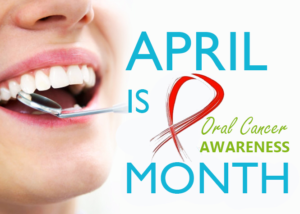April is Oral Cancer Awareness Month!
For the general population, April is a time for spring-cleaning, gardening, and Easter egg hunts. For dentists, it is time to turn our focus to a not-so-fun subject: Oral Cancer. At Designer Smiles, we remember oral cancer year-round, but in April, we emphasize raising awareness.
What is Oral Cancer?

Oral cancer is a classification of cancers found in the oral cavity. This designation encompasses cancers of the tissues of the mouth and the area at the back of the mouth toward the throat.
Most oral cancers (more than 90%) fall into the category of squamous cell carcinomas, which is also a cancer affecting the skin. This type of cancer arises in the outermost layer of the tissues lining the inside of the mouth.
What Has Changed in Oral Cancer?
Oral cancer is getting more attention now than ever before. Why? Because it is changing.
When Dr. Marcus Haggard was treating patients 40 years ago, it was easy to predict who would get oral cancer. Historically, the typical oral cancer patient was a 60-year-old white male smoker (or tobacco user). The risk was higher for those with both tobacco and alcohol use. These oral cancers typically presented on the sides of the tongue or floor of the mouth.
Nowadays, it is a different story. Oral cancer is occurring in younger people who have never smoked. And the cancer lesions are appearing further back in the mouth, near the opening of the throat (called the oropharynx).
The culprit: Human Papillomavirus.
Many people are familiar with this virus as a causative agent in cervical cancer in women. Its implication in oral cancer is gaining a strong foothold in scientific research. One recent Swedish study showed that 60% of tested oral cancer patients were infected with HPV.
It is a sexually transmitted virus that affects millions of Americans. Researchers estimate that over 80% of Americans will be infected with a strain of HPV at some point in their lifetimes.
Do All People with HPV get Oral Cancer?
Absolutely NOT!
Most strains of HPV are harmless and cleared from the body within 2 years of infection by your immune system. One specific strain, HPV16, is associated with cancers, and even if you have this strain, you are not destined to get cancer. It simply increases your risk.
You should be aware of whether or not you have the HPV virus so that you are more informed of your risk for oral cancer, as well as other cancers caused by HPV. You can ask your medical doctor to test you for the presence of the virus. Women, your Ob/Gyn likely tests for it each year during your yearly exam.
How Serious is Oral Cancer?
Very serious.
It can kill you. Early detection is the key to long-term survival. The later oral cancer is found, the lower your treatment success rate is.
Over 50,000 new cases of oral cancer are diagnosed each year, and one patient dies from oral cancer every hour.
This makes regular dental visits with a thorough oral cancer screening absolutely essential for your overall health! Dr. Ann, Dr. Lauren, and our wonderful dental hygienists are trained to spot suspicious or dangerous lesions in your mouth. By seeing them regularly, you improve your survival rate, should oral cancer arise.
Your dental evaluations are not just about teeth!
How is Oral Cancer Treated?
Like most cancers, there is usually a multifaceted approach to treatment. After the imaging and biopsies required to diagnose the presence of cancer, your treatment is coordinated between your dentist, an oral surgeon, and an oncologist.
The three common tools for stopping oral cancer in its tracks are surgery, chemotherapy and radiation. Each person is unique, and the treatment for cancer will also be unique.
When caught and treated early, the survival rate of oral cancer is high!
What Can You Do to Reduce the Risk of Oral Cancer?
- Stop the use of all tobacco products. Stop smoking. Stop dipping. Stop chewing. Tobacco is still a major factor in the development of oral cancer, and it’s the easiest one to control.
- Drink alcohol in moderation. Heavy alcohol use also increases the risk for oral cancer. Cut back on drinking to lower your chance of getting it.
- Practice safe sex and limit the number of sexual partners. The risk of HPV infection with cancer-causing strains goes up with each additional sexual partner, also contributing to spread of the virus.
- Keep your mouth healthy! Patients with years and years of dental disease have a much higher risk of developing oral cancer. Persistent infections in the mouth like gum disease and cavities make you more likely to get cancer.
- Perform a self-screening every month. Follow these guidelines from the American Association of Oral and Maxillofacial Surgeons to check out your mouth on a monthly basis. If you see anything unusual, make an appointment with Dr. Ann and Dr. Lauren as soon as possible.
- See your dentist regularly! We cannot emphasize the importance of this enough. Your dentist knows what the inside of the mouth should look like. Your dentist knows what oral cancer looks like. Catching it early is the key to beating it!
What Should You Look For in a Self-Exam?
When you evaluate the inside of your mouth, look for any unusual lumps, bumps or sores that do not blend in with the surrounding tissues. Look for ulcers, white patches, swellings or growths.
Pay attention to any changes in your swallowing pattern. HPV-related oral cancers often develop at the base of the tongue or in the opening to the throat. This can create an unusual sensation when swallowing.
If you see an area that looks like a white plaque or film, try to wipe it off with a small gauze. If it goes away, there is nothing to be concerned about. If it does not wipe off, monitor it closely each day for 2 weeks. If it does not change or gets larger, call us immediately.
A dentist needs to evaluate any ulcer or sore that does not heal within 2 weeks.
Do You or a Loved One have a Risk for Oral Cancer?
At Designer Smiles, we are all in for the fight against oral cancer. Please contact us immediately if you have concerns about oral cancer for yourself or your loved ones. We offer free oral cancer screenings, and we even have printed invitations you can take to your loved one. It costs you nothing, and it could save a life!
